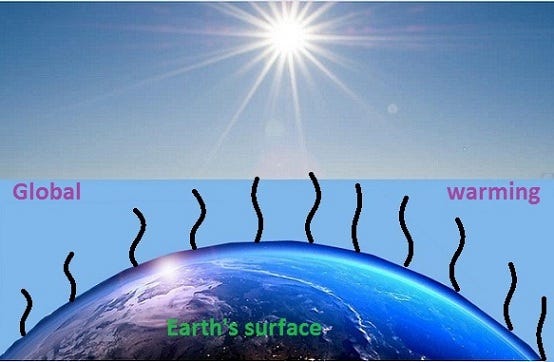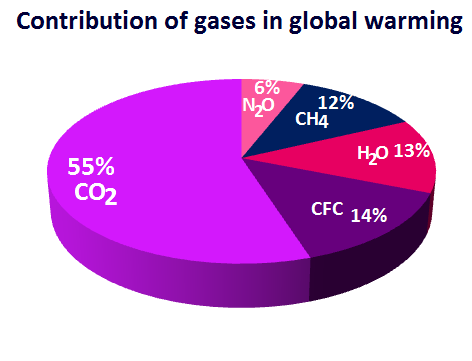What are the main causes of global warming in points?
Introduction of global warming
Global warming means an increase in the average temperature of the earth surface. The various greenhouse gases in the atmosphere (CO2, CH4, N2O, CFC, O3 and water vapor) are the causes of global warming.
This is because among all of greenhouse gases especially carbon dioxide, water vapor, CFC and CH4 are capable of absorbing infrared rays.

In the trap of greenhouse gases, heat energy spreads from the earth to space.
This heat is absorbed and emitted by these gases in the atmosphere in the form of infrared radiation.
This results in an increase in the lower atmosphere and the warming of the earth’s surface.
However, the amount of all these greenhouse gases in the atmosphere can increase for two reasons. Firstly due to various natural causes and secondly due to man-made causes.
Thus, various natural and man-made factors are indirectly responsible for global warming.
What is global warming in environmental science?
Global warming means an increase in the average temperature of the earth surface. The basic point is visible that light rays from the sun are incident on the earth’s surface.
One part of this light is absorbed by the earth’s surface and the other part is reflected back into space. This reflected part is absorbed by various gaseous elements in the atmosphere as it returns to space.
This increases the average temperature of the atmosphere. This phenomenon is called global warming.
What Are The Sources Of Global Warming (Greenhouse Gases)?
Before the industrial revolution, large amounts of greenhouse gases naturally heated the air around the bottom by about 33 degrees centigrade compared to their absence.
The use of fossil fuels increased after the beginning of the industrial revolution. This has led to increased production of other greenhouse gases, including CO2, in various developed and developing countries around the world.
As a result, the amount of greenhouse gases in the atmosphere can also increase.
For example, in the United States, the burning of fossil fuels to generate electricity is the largest source of thermal pollution. They produce about two billion tons of CO2 every year.
Coal burning power plants are by far the biggest polluters. The second largest source of CO2 is the transportation sector, which generates about 1.7 billion tons of CO2 emissions annually.
The reasons for the increase in greenhouse gases in the atmosphere are mentioned below.
Carbon dioxide
In addition to the United States, the burning of fossil fuels in many countries of the world, including India, China, Canada, and Russia, releases huge amounts of CO2 into the atmosphere from various fields.
Fossil fuels are used in various industries or in the production of energy required for the movement of vehicles.
Combustion of fossil fuels is the main source of carbon dioxide. These fossil fuels are mineral oil, coal, wood, etc.
Methane
Methane is produced in the decomposition of organic manure applied in paddy fields and other wetlands.
Methane is also released into the atmosphere as a result of decomposition of organic compounds from canals and muddy wetlands. Methane is also emitted from oil fields.
Water vapor
Sunlight produces a lot of water vapor from water bodies and the surface.
In addition, water vapor from boilers and steam engines used in various industries is released into the atmosphere.
Nitrous oxide ( N2O)
Nitrous oxide is produced by the combustion of N-derived compounds located in fossil fuels. Nitrous oxide is also produced in the decomposition of N-induced fertilizers.
Chlorofluoro carbon (CFC)
The source of CFC in the atmosphere is CFC that used as refrigerants in refrigerators, in air conditioners and in the preparation of perfume sprays, foams etc.
In addition, after welding the electric circuit, CFC mixes with the atmosphere during washing.
Ozone (O3)
Ozone in the troposphere is considered a greenhouse gas. In the presence of nitrogen oxides, hydrocarbons and oxygen, a small amount of ozone is formed in the troposphere during exposure to fog by sunlight.
Ozone gas is also produced by the reaction of water with fluorine produced by the decomposition of fluorine-containing compounds by unicellular animals in coastal areas.
How do greenhouse gases cause of global warming?
We know that the light energy that comes from the sun to the earth’s surface is basically visible light rays. This light energy is actually the cause of the increase in the temperature of the atmosphere.
Not all of these light rays are reflected by the earth’s surface and go into space. 34% of the incident light is reflected from the earth’s surface and goes back into space.
The remaining 66% is exploited by the earth.23% of this 66% light energy is used to evaporate water and to evaporate water vapor for the water cycle.
42% of this light energy is absorbed by the atmosphere, land and sea. It also costs a little less than 1% to move the air and keeps the seawater flowing.
A very small amount of total light energy i.e. 0.023% is expended for photosynthesis.
However, the light rays that are reflected from the earth’s surface and go back into space are basically infrared rays. Its wavelength is 7750 nm.
Now the whole region with the adjacent atmosphere is called the greenhouse of the earth. The CO2, CH4, N2O, CFC, O3 and water vapor in this atmosphere are known as greenhouse gases.
Among all of greenhouse gases, particularly carbon dioxide, water vapor, CFC and CH4 are capable of absorbing infrared rays.
Basically the C = O bond of carbon dioxide and the O-H bond of water vapor are capable of absorbing this infrared ray.
As a result, not all of the energy radiated from the earth’s surface can be returned. The Earth’s average (20ᵒC) temperature rises normally.
However, the role of carbon dioxide gas in global warming is the most. Carbon dioxide contributes 55% to global warming.
The contribution of various gaseous elements in the atmosphere in global warming is shown as a percentage.

Conclusion
There has been a recent global outbreak of the Covid-19 virus. For this reason many countries in the world, including India, observed lock down.
As a result, the traffic was completely stopped. Even many factories are closed for a long time.
Consequently a huge extent of CO2 reduces in the atmosphere. Therefore, environmentalists believe that global warming will be largely under control.
